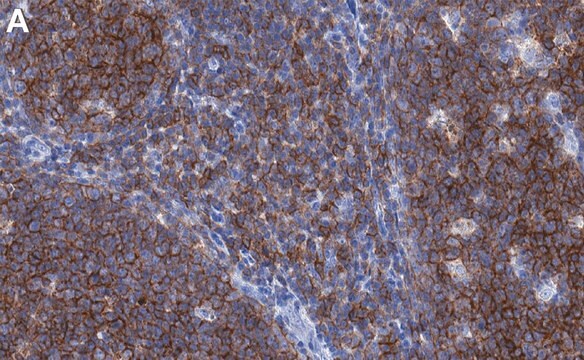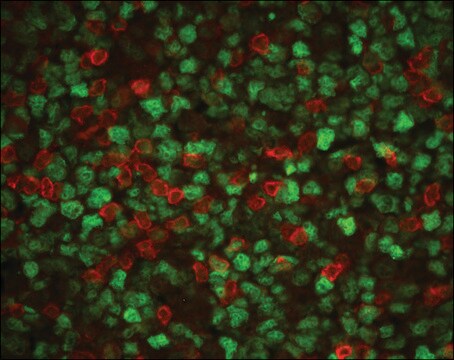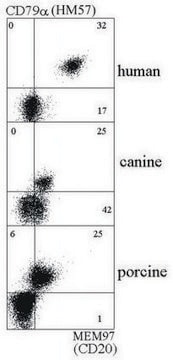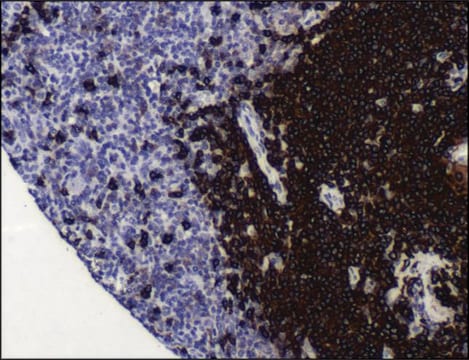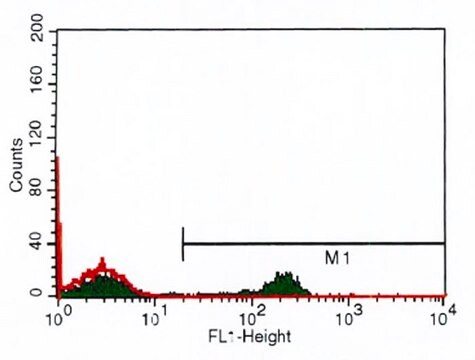추천 제품
생물학적 소스
mouse
Quality Level
결합
unconjugated
항체 형태
purified immunoglobulin
항체 생산 유형
primary antibodies
클론
2H7, monoclonal
양식
buffered aqueous solution
종 반응성
nonhuman primates, human
농도
1 mg/mL
기술
flow cytometry: 0.6 μg/mL
동형
IgG2b
NCBI 수납 번호
UniProt 수납 번호
배송 상태
wet ice
저장 온도
2-8°C
타겟 번역 후 변형
unmodified
유전자 정보
human ... MS4A1(931)
일반 설명
CD20 is a cell surface 33-37 (depending on the degree of phosphorylation) kDa non-glycosylated surface phosphoprotein expressed on mature and most malignant B cells, but not stem cells or plasma cells (low number of the CD20 has been also detected on a subpopulation of T lymphocytes and it can be expressed on follicular dendritic cells). Its expression on B cells is synchronous with the expression of surface IgM. CD20 regulates transmembrane calcium conductance (probably functioning as a component of store-operated calcium channel), cell cycle progression and B-cell proliferation. It is associated with lipid rafts, but the intensity of this association depends on extracellular triggering, employing CD20 conformational change and/or BCR (B cell antigen receptor) aggregation. After the receptor ligation, BCR and CD20 colocalize and then rapidly dissociate before BCR endocytosis, whereas CD20 remains at the cell surface. CD20 serves as a useful target for antibody-mediated therapeutic depletion of B cells, as it is expressed at high levels on most B-cell malignancies, but does not become internalized or shed from the plasma membrane following mAb treatment.
The CD20 gene, mapped to human chromosome 11q12-13, codes for a B lymphocyte differentiation antigen. The protein encoded by the gene is a 33kDa transmembrane phosphoprotein, specifically expressed in normal and neoplastic B-cells. CD20, also known as MS4A1, is a member of membrane-spanning 4-domains subfamily A (MS4A) family of molecules with multiple membrane spanning domains.
특이성
The antibody 2H7 reacts with CD20 (Bp35), a 33-37 kDa non-glycosylated membrane receptor with four transmembrane domains, expressed on B lymphocytes (it is lost on plasma cells), follicular dendritic cells, and at low levels on peripheral blood T lymphocytes.
면역원
Human tonsillar B cells
애플리케이션
The reagent is designed for Flow Cytometry analysis. Suggested working dilution for Flow Cytometry is 0.6 μg/mL of sample. Indicated dilution is recommended starting point for use of this product. Working concentrations should be determined by the investigator.
생화학적/생리학적 작용
Restricted expression pattern of CD20 in B- cells helps in distinguishing B-cell from T-cell lymphomas. CD20, is considered to be a potential therapeutic target in the treatment of B-cell malignancies such as diffuse large B-cell lymphoma and chronic lymphocytic leukemia. CD20, might act as an ion channel, thereby permitting the influx of calcium essential for B cell activation, proliferation and differentiation. In humans CD20 deficiency, leads to impaired T cell–independent antibody responses. The monoclonal anti-CD20 antibody, Rituximab (RTX) reduces the increased CD20 expressing T cells in multiple sclerosis patients.
특징 및 장점
Evaluate our antibodies with complete peace of mind. If the antibody does not perform in your application, we will issue a full credit or replacement antibody. Learn more.
물리적 형태
Solution in phosphate buffered saline, pH 7.4, with 15 mM sodium azide.
면책조항
Unless otherwise stated in our catalog or other company documentation accompanying the product(s), our products are intended for research use only and are not to be used for any other purpose, which includes but is not limited to, unauthorized commercial uses, in vitro diagnostic uses, ex vivo or in vivo therapeutic uses or any type of consumption or application to humans or animals.
적합한 제품을 찾을 수 없으신가요?
당사의 제품 선택기 도구.을(를) 시도해 보세요.
Storage Class Code
10 - Combustible liquids
Flash Point (°F)
Not applicable
Flash Point (°C)
Not applicable
Katrin A Salva et al.
The American Journal of dermatopathology, 37(10), e116-e121 (2015-09-19)
Expression of the pan B-cell marker CD20 by T-cell lymphoproliferative disorders is exceedingly rare. We present a 52-year-old man with a unilesional cutaneous CD20 T-cell lymphoproliferative disorder. Multispectral imaging analysis of CD3-CD20 double-stained lesional tissue sections allowed (1) the visualization
Taco W Kuijpers et al.
The Journal of clinical investigation, 120(1), 214-222 (2009-12-30)
CD20 was the first B cell differentiation antigen identified, and CD20-specific mAbs are commonly used for the treatment of B cell malignancies and autoantibody-mediated autoimmune diseases. Despite this the role of CD20 in human B cell physiology has remained elusive.
Arumugam Palanichamy et al.
Journal of immunology (Baltimore, Md. : 1950), 193(2), 580-586 (2014-06-15)
In multiple sclerosis (MS), B cell-depleting therapy using monoclonal anti-CD20 Abs, including rituximab (RTX) and ocrelizumab, effectively reduces disease activity. Based on indirect evidence, it is generally believed that elimination of the Ag-presenting capabilities and Ag nonspecific immune functions of
T F Tedder et al.
Journal of immunology (Baltimore, Md. : 1950), 142(7), 2555-2559 (1989-04-01)
The human CD20 gene (B1) encodes a B lymphocyte-specific, cell-surface molecule that is involved in B cell activation and differentiation. We report that the CD20 gene is located on human chromosome 11 at position q12-q13. The location of CD20 was
Jessica L Teeling et al.
Journal of immunology (Baltimore, Md. : 1950), 177(1), 362-371 (2006-06-21)
We have previously defined a panel of fully human CD20 mAb. Most of these were unexpectedly efficient in their ability to recruit C1q to the surface of CD20-positive cells and mediate tumor lysis via activation of the classical pathway of
자사의 과학자팀은 생명 과학, 재료 과학, 화학 합성, 크로마토그래피, 분석 및 기타 많은 영역을 포함한 모든 과학 분야에 경험이 있습니다..
고객지원팀으로 연락바랍니다.